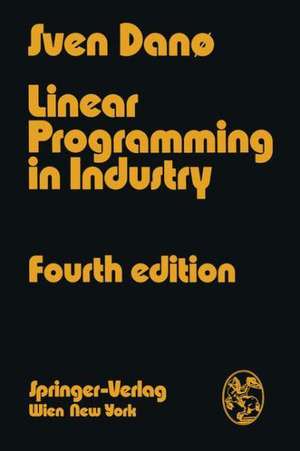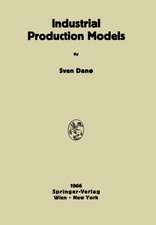Linear Programming in Industry: Theory and Applications An Introduction
Autor Sven Danoen Limba Engleză Paperback – 8 mar 1974
Preț: 381.43 lei
Nou
Puncte Express: 572
Preț estimativ în valută:
72.99€ • 78.05$ • 60.85£
72.99€ • 78.05$ • 60.85£
Carte tipărită la comandă
Livrare economică 17 aprilie-01 mai
Preluare comenzi: 021 569.72.76
Specificații
ISBN-13: 9783211811894
ISBN-10: 3211811893
Pagini: 188
Ilustrații: XII, 172 p.
Dimensiuni: 152 x 229 x 10 mm
Greutate: 0.26 kg
Ediția:Softcover reprint of the original 4th ed. 1974
Editura: SPRINGER VIENNA
Colecția Springer
Locul publicării:Vienna, Austria
ISBN-10: 3211811893
Pagini: 188
Ilustrații: XII, 172 p.
Dimensiuni: 152 x 229 x 10 mm
Greutate: 0.26 kg
Ediția:Softcover reprint of the original 4th ed. 1974
Editura: SPRINGER VIENNA
Colecția Springer
Locul publicării:Vienna, Austria
Public țintă
ResearchCuprins
I. Introduction.- A. Planning Company Operations: The General Problem.- B. Linear Planning Models.- C. A Simple Example.- II. Elements of the Mathematical Theory of Linear Programming.- A. The Fundamental Theorem.- B. The Simplex Method and the Simplex Criterion.- III. A Practical Example.- IV. Industrial Applications.- A. Blending Problems.- B. Optimal Utilization of Machine Capacities.- C. Inventory Problems.- D. Transportation Problems.- E. Linear Investment Planning.- V. Computational Procedures for Solving Linear Programming Problems.- A. The Simplex Method.- B. The Simplex Tableau.- C. Alternate Optima and Second-Best Solutions.- D. Computational Short Cuts.- E. The Case of Degeneracy.- F. Procedure for Solving Transportation Problems.- VI. Duality in Linear Programming.- A. The Duality Theorem.- B. Economic Interpretation of the Dual.- C. The Dual Simplex Method.- VII. Sensitivity Analysis and Parametric Programming.- A. Sensitivity Analysis.- B. A Concrete Example of Sensitivity Analysis.- C. Parametric Linear Programming.- VIII. Integer Linear Programming.- A. Integer Programming and Solution by Rounding.- B. Solution by Cuts. Pure Case.- C. Solution by Cuts. Mixed Case.- D. Solution by a Branch-and-Bound Procedure.- E. O — 1 Programming.- F. Computer Solution.- IX. Decomposition.- A. Decomposition and Decentralized Planning.- B. Decomposition by Direct Allocation.- C. Decomposition by Shadow Prices.- X. Appendix.- A. Proof of the Fundamental Theorem.- B. The Simplex Criterion.- C. The Simplex Algorithm.- D. Proof of the Duality Theorem.- E. Gomory’s Algorithms for Integer Programming.- F. A Decomposition Theorem.- References.

















